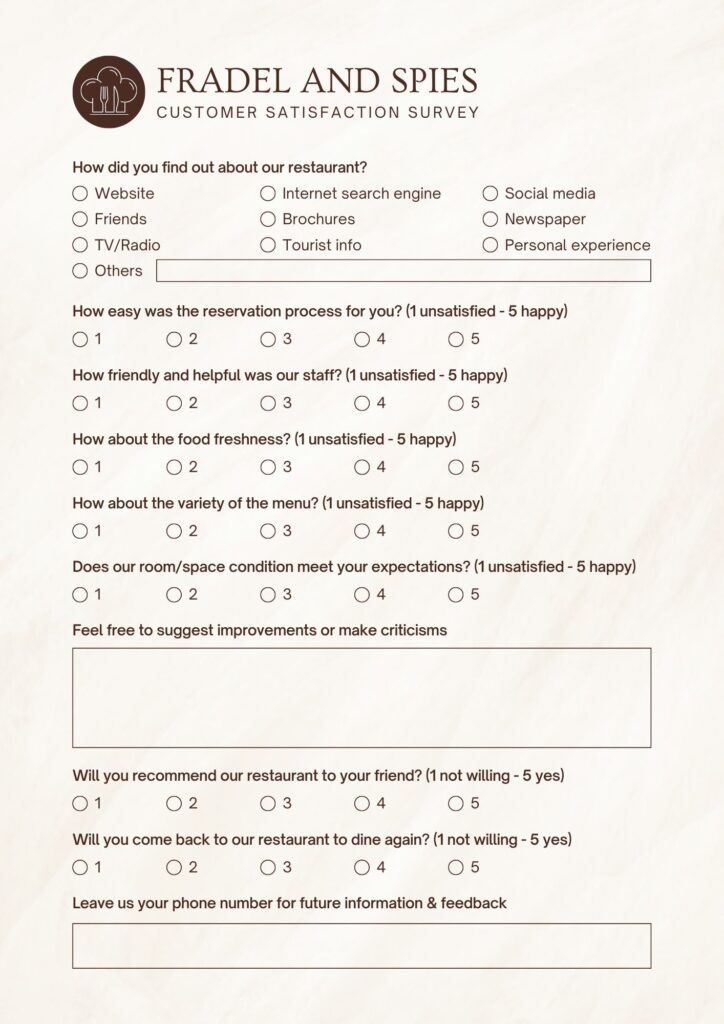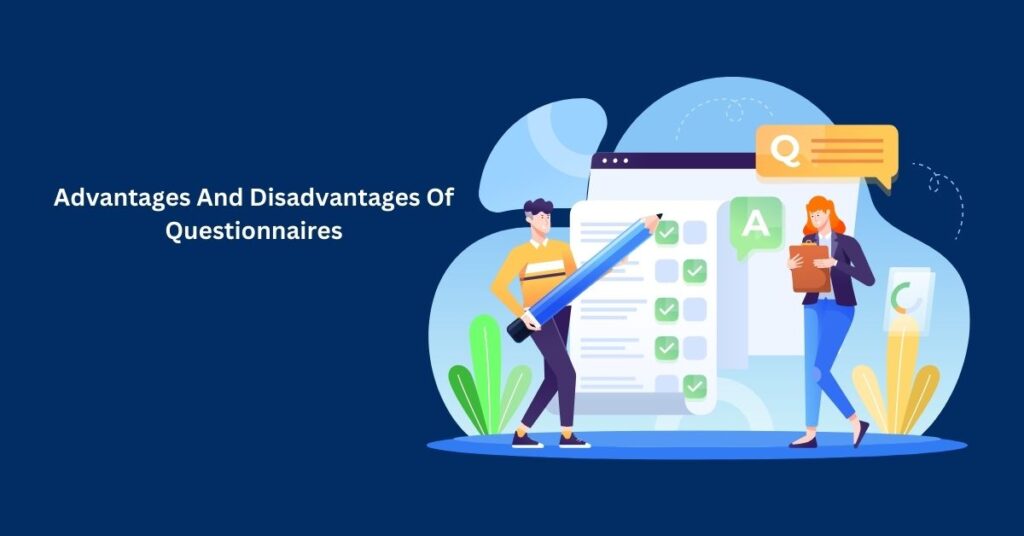Questionnaires are a popular exploration tool that experimenters have employed for decades. It’s a data collection system that involves asking a set of standardized questions to a sample population.
Questionnaires can be used in colorful exploration fields and can be distributed through different channels like dispatch, social media, or indeed in-person interviews. Despite the fashionability of questionnaires, there are both advantages and disadvantages to using them as an exploration tool.
Questionnaires are a common data collection tool used by experimenters across different fields. They’re considered an effective way to collect data from many people with a low cost and trouble.
Still, there are also implicit downsides to using questionnaires that should be taken into consideration before deciding on the stylish data collection system for a particular exploration design. Let’s explore the Advantages and Disadvantages of Questionnaires.
what is a questionnaire in research?
It is a list of questions like objective questions that are used to gather data from other people. Or Questionnaire is a method by which we check other people’s opinions, emotions, attitudes, and experiences.
What are the 4 types of questionnaires?
- Structured Questionnaire
- Unstructured Questionnaire
- Open-ended Questionnaire
- Close-ended Questionnaire
Advantages and Disadvantages of Questionnaires
Questionnaires have many advantages and disadvantages more flexible, way of efficient for data collection, they have greater control over response, and less interview bias disadvantages include limited depth of information sometimes, limited response rate, design, and formatting issues, cannot to explore complex issues, and many more. Let’s explore this.
Advantages of Questionnaires
There are endless benefits of questionnaires and there are many tools and apps that we can use to create questionnaires. SurveyMonkey, Mopinion, Feedier, HubSpot, Paperform, and more.
1. Wide content and availability
One of the main advantages of questionnaires is their capability to reach a wide and different population. The internet has made it possible to distribute questionnaires to individuals from all over the world, adding to the reach of the study.
Also, questionnaires can be designed to feed to different languages, making them accessible to non-native English speakers.
2. Cost-effective
Questionnaires are a cost-effective way of collecting data. Experimenters don’t need to travel to different locales to gather data, nor do they need to hire staff to conduct checks. With online questionnaires, experimenters can collect data spending no plutocrat on printing or postage.
3. Anonymity and confidentiality
Questionnaires can be distributed anonymously, furnishing a position of confidentiality to replies. This allows actors to give honest and veracious answers without fear of judgment or retaliation.
Also, experimenters can assure reporters that their particular information will be kept nonpublic and won’t be participated with anyone outside the exploration platoon.
4. Consistency and community of responses
Questionnaires give harmonious and similar responses. Since all actors admit the same questions, it’s easier to compare and dissect data. Also, standardized questions help exclude confusion or misconstructions that may arise from open- concluded responses.
5. Convenience
Questionnaires are accessible for both experimenters and repliers. Experimenters can collect data from anywhere, as long as they have an internet connection. Repliers can complete the questionnaire at their convenience and don’t need to record an appointment or take time off work.
6. Large sample size
Questionnaires can also gather data from a large sample size. This is because it can distribute them to many people at once. This can be helpful when researchers are trying to gather data from a specific population, such as a particular demographic or geographic region.
7. Easy to analyze data
Finally, questionnaires are easy to analyze. Because the responses are typically in a standardized format, researchers can quickly and easily input the data into a computer program for analysis.
This can help to identify patterns or trends in the data, which can be helpful for drawing conclusions and making recommendations.

Disadvantages of Questionnaires
Like the benefits of the questionnaires, it has drawbacks we should consider before using questionnaires that will be helpful.
8. Low response rates
One of the main disadvantages of questionnaires is their low response rate. Not all actors who admit to a questionnaire will complete it, and this can significantly affect the validity and trust of the data collected.
Response rates can be bettered by offering impulses to actors or by following up with non-respondents.
9. Potential for replier bias
Replier bias occurs when repliers give answers they believe the experimenter wants to hear. This can lead to inaccurate data and deceptive results.
Experimenters can reduce the eventuality of bias by designing unprejudiced questions and assuring repliers of the confidentiality of their answers.
10. Limited data
Limited data is a disadvantage of questionnaires, as they’re limited to the questions asked. Experimenters may miss important information that isn’t covered by the check. Also, questionnaires may not capture the nuances and complications of certain motifs.
Therefore, it’s important for experimenters to precisely design their questionnaires to ensure that they captured all applicable information.
Experimenters may also consider combining questionnaires with other data collection styles to get a further comprehensive understanding of the content being studied.
11. Limited open-concluded responses
Another disadvantage of questionnaires is the limited nature of open-conclusion responses. While open-concluded questions allow actors to partake in their studies and passions in their own words, the responses can be delicate to dissect and interpret.
Experimenters may also struggle to compare and group open- concluded responses in a meaningful way, making it harder to draw conclusions from the data.
Therefore, experimenters may choose to use a combination of unrestricted-concluded and open-concluded questions in their questionnaires to gather both quantitative and qualitative data.
12. Poor question design
Poor question design is a common pitfall of questionnaires. However, actors may give inaccurate or deficient responses, If questions are unclear or confusing. Experimenters must ensure that questions are designed in a way that’s easy for actors to understand and answer.
This may involve using simple language, avoiding slang or specialized terms, and furnishing clear instructions on how to answer the question.
Also, experimenters must avoid prejudice or commanding questions that may impact actors’ responses. By taking the time to precisely design their questionnaires, experimenters can ensure that the data they collect is accurate and dependable.
13. Inability to Clarify Questions
In questionnaires, researchers cannot clarify the questions for respondents. This can be problematic if the respondents do not understand the questions or if they interpret them differently. The inability to clarify questions can cause incorrect or incomplete responses.

14. Limited Context
Questionnaires provide a limited context for the research topic. The researchers may miss important information that would have been gathered through other data collection methods such as interviews or observation.
15. Reliability and Validity Issues
Finally, there are reliability and validity issues with questionnaires. The questions may not accurately measure what it intended them to measure, or the respondents may not answer truthfully.
The reliability and validity of the data collected through questionnaires can be compromised if the questionnaire is poorly designed.
| How to Design an Effective Questionnaire |
|---|
| Despite the disadvantages of questionnaires, they can be effective if designed properly. Here are some tips on how to design an effective questionnaire: 1. Define the Research Question Defining the research question is a crucial step in designing a questionnaire. The research question should clearly state the problem or issue that the questionnaire aims to address and guide the selection of the questions that will be included. It’s important to ensure that the research question is specific and focused, as this will help to avoid confusion and ensure that the data collected is relevant and useful. The research question should be informed by existing literature or research in the field and should be tailored to the specific context of the study. 2. Determine the Target Population The target population is the group of people we designed the questionnaire to collect data from. It’s important to identify the characteristics of the target population, such as age, gender, education level, and occupation. 3. Choose Question Types There are various types of questions to choose from when designing a questionnaire, including closed-ended, open-ended, and Likert scale questions. It’s important to choose the question type that will provide the most accurate and relevant data. 4. Use Clear and Concise Language Using clear and concise language in questionnaires is essential for ensuring that respondents understand the questions being asked and can provide accurate answers. Complex or ambiguous language can lead to confusion or misunderstandings, which can cause inaccurate or incomplete data. It’s important to use simple and straightforward language that is easy to understand, avoiding technical jargon or overly complicated phrasing. Using clear instructions and examples can help to clarify the purpose of the questionnaire and guide respondents in how to answer the questions. 5. Test the Questionnaire Before using a questionnaire on a larger scale, it’s important to test it out to identify any potential issues or areas for improvement. This can involve conducting a small pilot study with a sample of participants to see how they respond to the questionnaire and if they have any difficulty understanding the questions or providing answers. Testing can also help to determine if the questions are asking the right information and if the responses are providing the desired data. Adjustments can be made to the questionnaire based on the results of the pilot study to ensure it is effective and efficient. |
People also ask
What’s a disability benefits questionnaire?
A disability benefits questionnaire is a document used by government agencies or insurance companies to assess a person’s eligibility for disability benefits.
The questionnaire asks for detailed information about the person’s medical condition, diurnal conditioning, work history, and other factors that may affect their capability to work.
How do you spell questionnaires?
The word” questionnaires” is spelled as follows: Q-U-E-S-T-I-O-N-N-A-I-R-E-S.
What is Secret Santa questionnaire?
A Secret Santa questionnaire is a form that actors in a Secret Santa gift exchange fill out to give information about their interests, pursuits, and preferences.
The person buying a gift for that individual to help them elect a thoughtful and applicable gift also used the information.
Conclusion
Questionnaires have both advantages and disadvantages as a data collection system. They’re an accessible and cost-effective way to gather large quantities of data from a wide range of actors.
Still, they also have limitations, similar to limited data, limited open- concluded responses, and poor question design. Experimenters must precisely design their questionnaires to ensure that they’re collecting accurate and dependable data.
Combining questionnaires with other data collection styles can also give a further comprehensive understanding of the content being studied.
Overall, questionnaires can be a precious tool for experimenters when used to meet and courteously. We hope you enjoy the pros and cons of questionnaires. If something is missing then tell us in the comment section.

